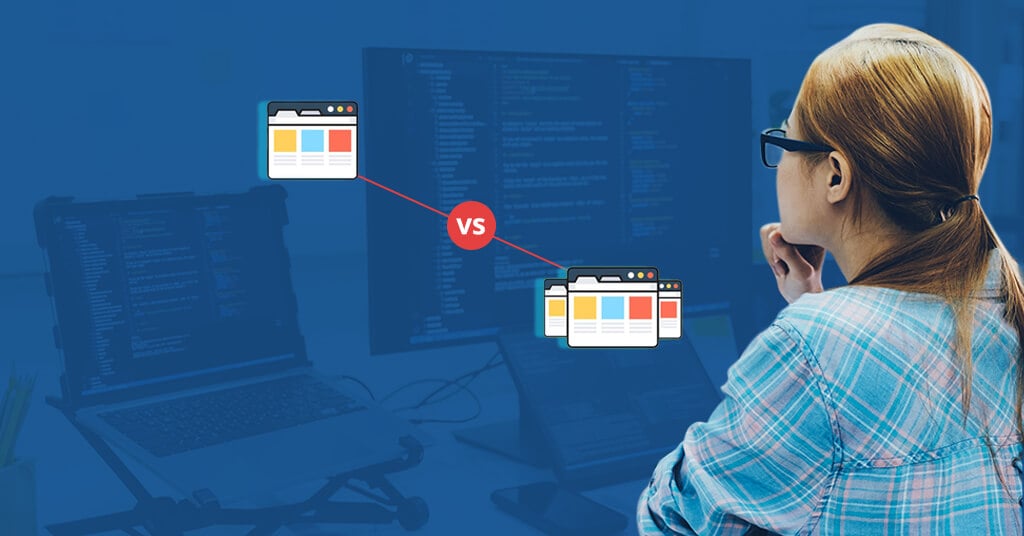Both, single-page applications (SPAs) and multi-page applications (MPAs) are web development solutions that can help businesses build their online presence.
Choosing the right one to develop your business website is essential for crafting memorable online experiences for your audience while keeping business IT capabilities in focus.
A Quick Look at Some Key Differences in SPAs and MPAs
Single-Page Applications (SPAs) | Multi-Page Applications (MPAs) |
Load a single HTML page and dynamically update content as users interact with it, providing a seamless, responsive user experience. | Multiple interconnected HTML pages for separate views or functions. Navigation involves requests to the server, resulting in full page reloads. |
Requires extensive front-end development skills and can be less SEO-friendly. | Easier to develop and tends to have better SEO capabilities due to distinct URLs for each page. |
Utilize JavaScript frameworks like React or Angular to handle client-side routing and data retrieval. | Depends on server to update or refresh page(s) and send it to browser (where the user views it). |

Choosing the Right Application Structure
The structure of the web application will determine the code organization as well as the interaction between components, ease of debugging, and testing. An incorrectly deployed application has the capacity to slow down development, increase maintenance costs, and lead to code complexity.
Whether it is SPA architecture or MPA models, choosing the correct application structure ensures deliverables and projects are aligned with customer expectations, including easier navigation. A choice between the two will also need to take into consideration business capabilities and requirements such as effective scaling, as well as promoting better collaboration among the development teams. Ultimately, the right application structure promotes a successful and sustainable online presence.
A Quick Comparison of Features Available in SPA and MPA
Advantages of SPA models
- Seamless User Experience: Offers a fluid and responsive user experience, reducing page reloads.
- Faster Load Times: Loads resources dynamically, resulting in quicker initial load times.
- Enhanced Interactivity: Enables complex interactions and real-time updates without full-page refreshes.
- Code Reusability: Shares code and components, making development efficient.
- Mobile-Friendly: Responsiveness as a feature makes it well-suited for mobile applications.
- Offline Support: Enabling users to access certain functions even when they are not connected to the internet.
- Makes A Website Engaging and Unique: SPA offers a seamless, dynamic, and interactive browsing experience.
- Better Conversions: SPAs help increase conversion rates by lowering latency and facilitating faster navigation.
Limitations of SPA models
- SEO Challenges: Search engines may struggle to index JavaScript-driven content.
- Initial Load Time: First load can be slower due to the need to fetch JavaScript and data resources.
- Complex Development: Complex to develop and require extensive front-end expertise.
- Accessibility: Navigating between pages can be more challenging. Depending on the website interface, pressing the back button may lead the user completely out of the website they are browsing, and not necessarily to the previous screen.
- Security Problems: It could face security issues such as client-side vulnerabilities and the possibility of unauthorized access.
- Scalability Problems: Scalability issues may arise as a result of the increased complexity of managing client-side logic, particularly in large applications.
Some Best Practices for Developing SPAs
- Optimize Initial Load: Minimize initial load times by code-splitting and lazy-loading resources.
- SEO Strategy: Implement server-side rendering or use prerendering techniques for SEO optimization.
- State Management: Use a robust state management library for efficient data handling.
- Performance Monitoring: Continuous monitoring of performance is possible in SPAs. This allows developers to optimize performance.
- Security: Implement input validation and authentication for proper security measures.
- Accessibility: Prioritize accessibility for usability.
- Scalability: SPA architecture should be created to scale easily by optimizing server resources and leveraging efficient client-side rendering.
Advantages of Multi-Page Applications (MPAs)
- SEO-Friendly: Better SEO capabilities due to distinct URLs for each page.
- Simpler Development: Easy to develop and maintain, making them a good choice for smaller projects.
- Graceful Degradation: Works even when JavaScript is disabled in the browser.
- Well-Established: Conventional web development approach with many resources available.
- Easy to Analyze: MPA facilitates thorough analysis by simplifying issue identification and debugging through distinct pages.
- Scalability: MPA architectures’ modular scalability accommodates complexity without compromising performance.
- Several Development Solutions: MPAs’ diverse page-centric structure enables the use of a wide range of development solutions and technologies.
Limitations of Multi-Page Applications (MPAs)
- Slower User Experience: Full page reloads lead to a less seamless experience.
- Limited Interactivity: Complex interactions and real-time updates may be less efficient.
- Higher Server Load: Each page load requires a server request increasing server load.
- Less Responsive: Full page transitions may feel less responsive compared.
- Complex to Develop and Maintain: It is difficult to develop and maintain, making it less flexible and scalable.
- More Development Time: Takes longer to develop as navigation and page loading are separate.
- Cost: Costs more to build and maintain due to increased server needs for frequent page requests.
Some Best Practices for Developing MPAs
- Clean URL Structure: Maintain clean and meaningful URLs for better SEO and user experience.
- Server-Side Rendering: Improve initial load times using server-side rendering.
- Caching: Implement caching mechanisms for frequently accessed pages.
- Code Modularity: Organize code into reusable modules for maintainability.
- Security: Apply security best practices, including input validation and authentication.
- Responsive Design: Ensure a responsive design for various device types.
Partnering with Experts: Choosing Right
Given the need for proper testing, documentation, and version control for both SPAs and MPAs, partnering with experts can prove to be the best approach for businesses considering the right application structure. Benefits of partnering with experts:
- Ensures IT structure aligns with your project’s unique goals and requirements.
- Helps your business navigate the complexities of development, optimize performance, and address potential challenges effectively.
- Enables collaboration with specialists for customized business solutions that save time and reduce risks.
Ready to partner with an experienced, proven web application development company and experience profitability alongside business growth? If so, get in touch with our experts today.
For any inquiries, email us at sales@analytix.com or call us at 781.503.9003.
